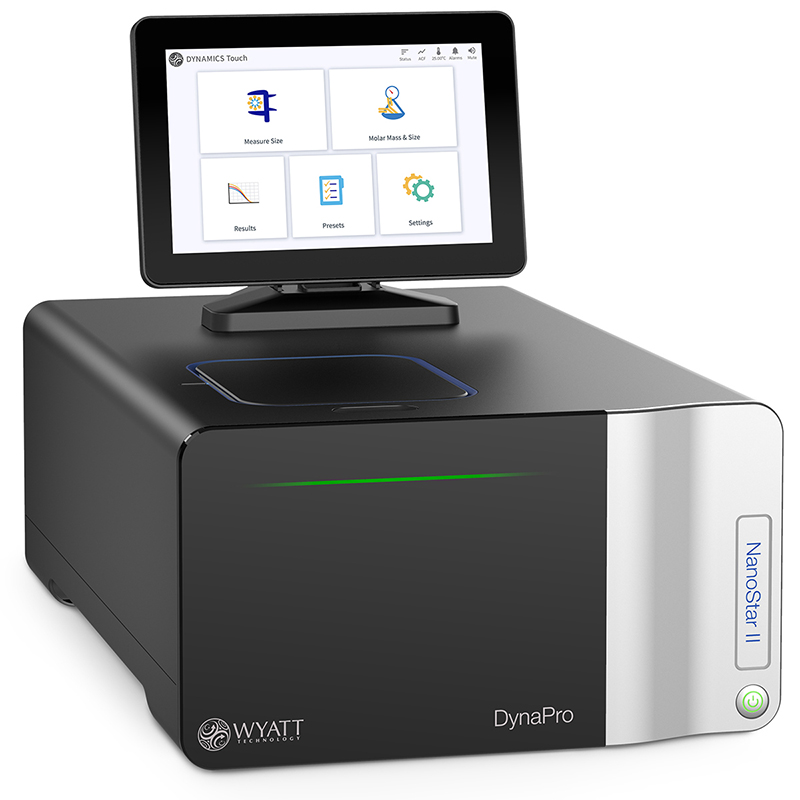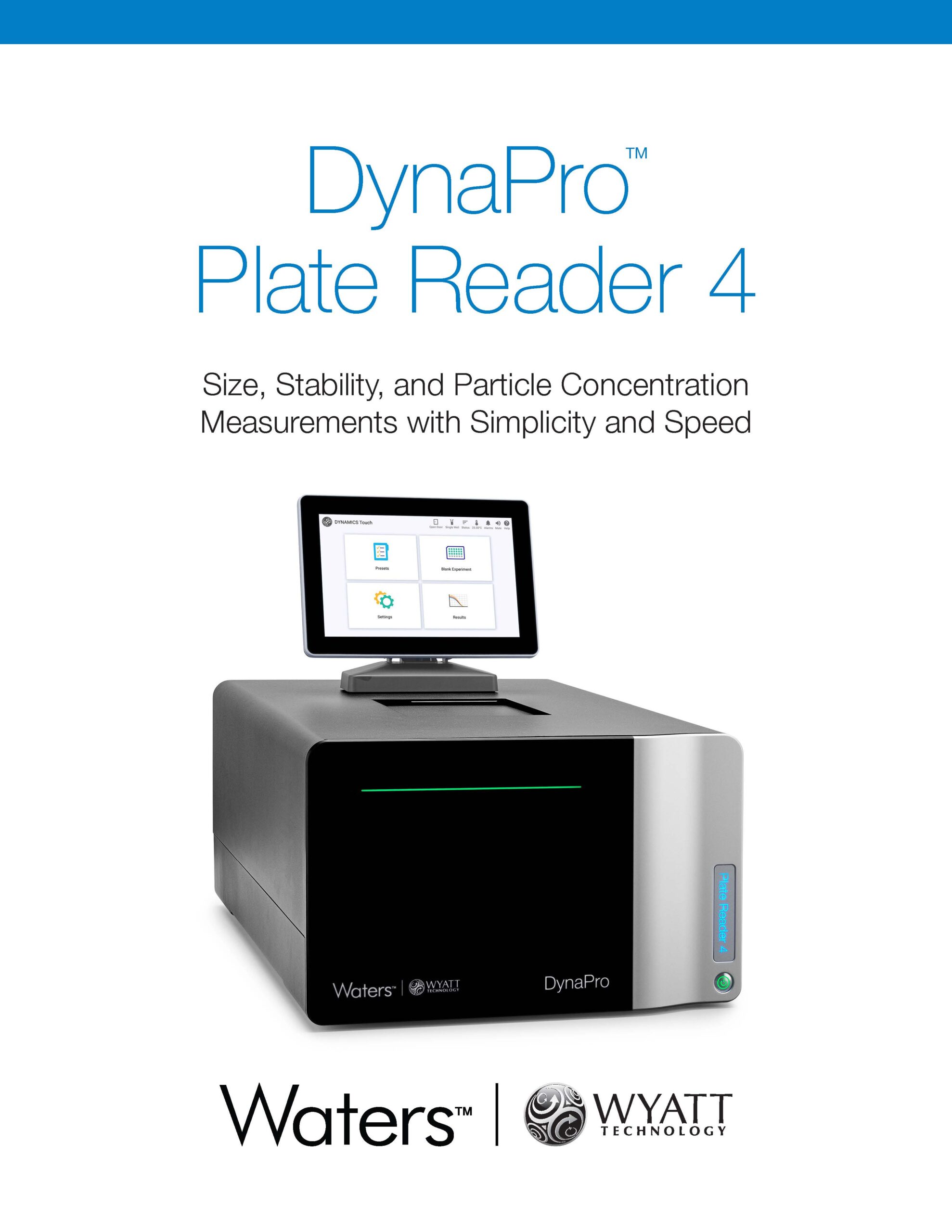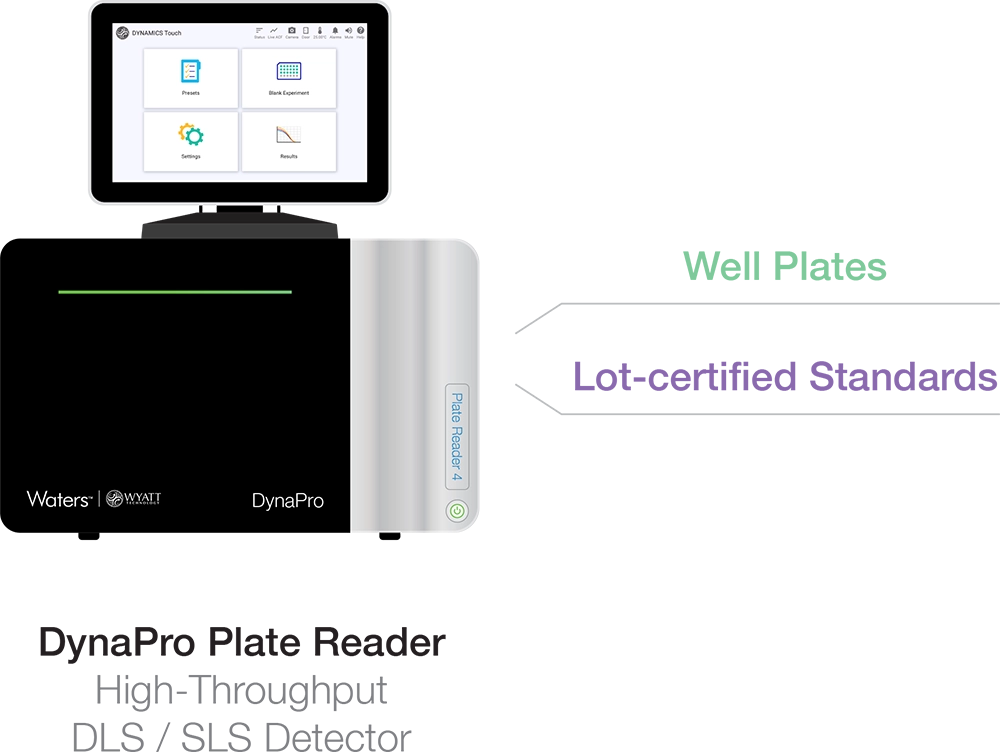DynaPro™ Plate Reader
Product Overview
Product Description
Brochure
Videos
Advanced Features
Robotic Liquid Handling
Accessories
Software
Specifications
Other DLS & ELS Instruments
Publications
Request Info
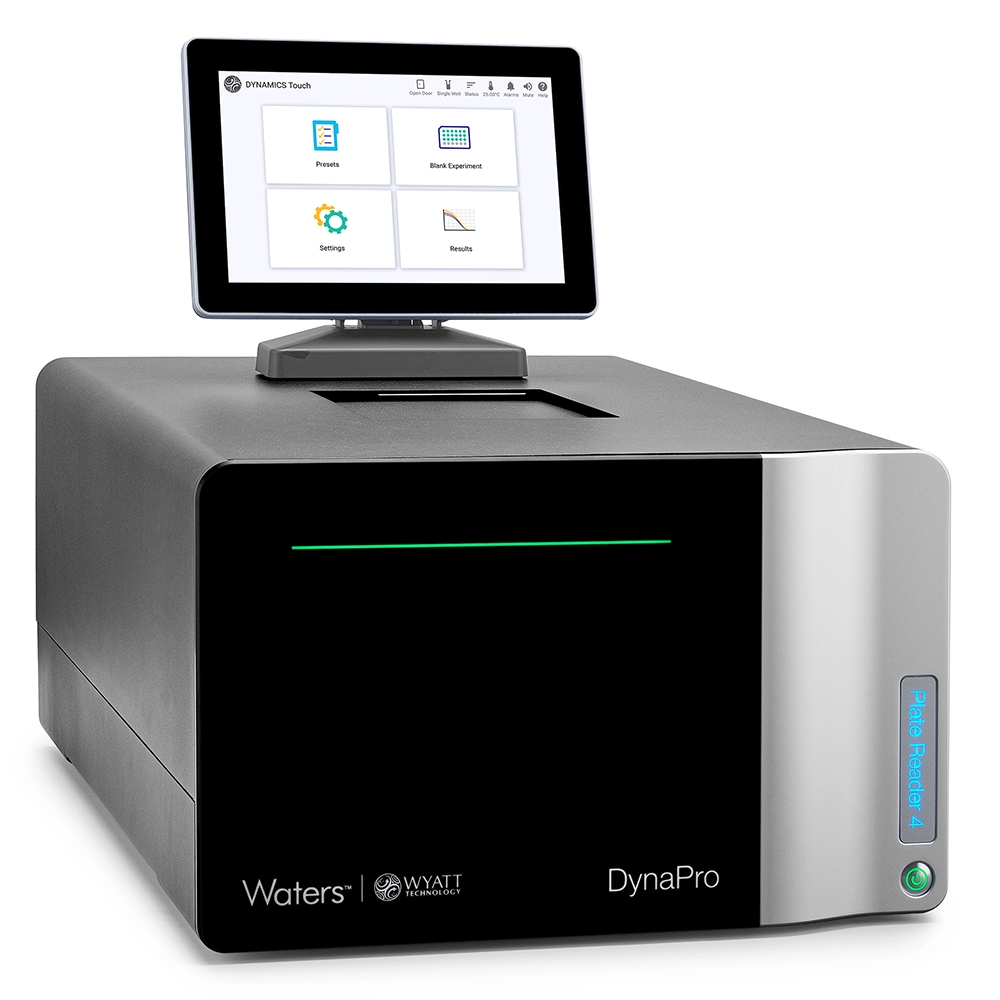
High-throughput, automated, dynamic and static light scattering
Upgrade to plates
Revolutionize your performance by replacing your conventional, cuvette-based dynamic light scattering unit with the automated DynaPro Plate Reader. The DynaPro excels at high-throughput sizing and screening of pharmaceutical and nanoparticle formulations to enable novel workflows that simply would not be possible with other DLS instruments. Even if you need to run just a handful of samples, it's a great productivity booster.
Walk-up operation with DYNAMICS Touch™
Comprehensive solution
For biotherapeutic development, the DynaPro Plate Reader is a comprehensive solution for stability evaluation. Measure aggregation, aggregate size distributions, changes in solution molecular weight, and propensity for aggregation: indicators of both thermal stability (Tonset, Tm, Tagg) and colloidal stability (A2/B22, kD) may be quantified with plate-based DLS and SLS. Even viscosity of concentrated protein solutions can be screened across dozens of formulations in a single plate.
For nanoparticle formulation and process development, including viral vectors, non-viral vectors and nano-drug delivery vehicles, the DynaPro adds particle concentration / physical titer to basic DLS measurements of size and polydispersity. Its automation is particularly valued to screen fractions during process development and then to quantify CQAs in quality control.
Compatible with DYNAMICS™
The DynaPro Plate Reader is operated by DYNAMICS, our powerful software package for collecting, analyzing, and reporting automated batch dynamic and static light scattering data.
DYNAMICS is offered with a 21 CFR Part 11 compliant Security Pack option, enabling the use of the DynaPro Plate Reader in a GMP environment.
Revolutionize DLS
The DynaPro Plate Reader offers dynamic light scattering (DLS) and static light scattering (SLS) measurements of the size, molecular weight, concentration and interactions of proteins, nanoparticles and other macromolecules in situ in industry-standard microwell plates. No liquid handling occurs after dispensing into the plates, to maximize throughput and minimize sample carryover. This ground-breaking instrument provides rapid optimization of the formulation process for:
- Biotherapeutics such as monoclonal antibodies and virus-like particles (VLPs)
- Nanoparticle drug delivery vehicles including liposomes and conjugated gold NPs
- Viral and non-viral gene vectors like AAV, adenovirus, lentivirus and LNP
A wealth of applications
The DynaPro Plate Reader provides unparalleled levels of ease-of-use, productivity, reproducibility, and flexibility in order to address additional demanding applications such as:
- Assessing aggregation or oligomerization
- Quantifying AAV titer for multiple processes
- Determining protein stability-indicating parameters such as thermal denaturation and colloidal stability
- Optimizing protein crystallization
- Screening high-concentration protein solutions for reversible association and viscosity
Key features
- Measure hydrodynamic radius from 0.5 nm to 1000 nm
- Determine particle concentration for particles up to 320 nm in diameter
- Sensitivity for size down to 0.125 mg/mL lysozyme
- Measure weight-average molar mass from 1 to 1000 kDa
- Industry-standard microwell plates of 96, 384 or 1536 wells
- Sample volume from 4 μL to 150 μL
- All measurements made in situ in the wells
- Temperature ramps from 4 °C to 85 °C
- Integrates with plate-based liquid handling robotics
Automated characterization of size, stability and molecular weight in industry-standard microwell plates
Click here to request a copy of our DynaPro Plate Reader brochure.
Introducing the DynaPro Plate Reader 4
A wealth of features
- Rapid or slow temperature ramps 4 °C to 85 °C with excellent uniformity across the plates. Samples are heated in parallel and all filled wells measured at each temperature.
- Well read times as short as 5 to 10 seconds
- Seal wells with oil or sealing tape to prevent evaporation. The tape is gently heated to prevent condensation.
- Integration with liquid-handling robots for higher levels of automation, especially when your workflow is plate-based, and utilizes spectroscopic and other plate readers in addition to DLS/SLS
- A camera for viewing each well from below, to aid in data diagnostics (e.g. to detect precipitation or bubble formation)
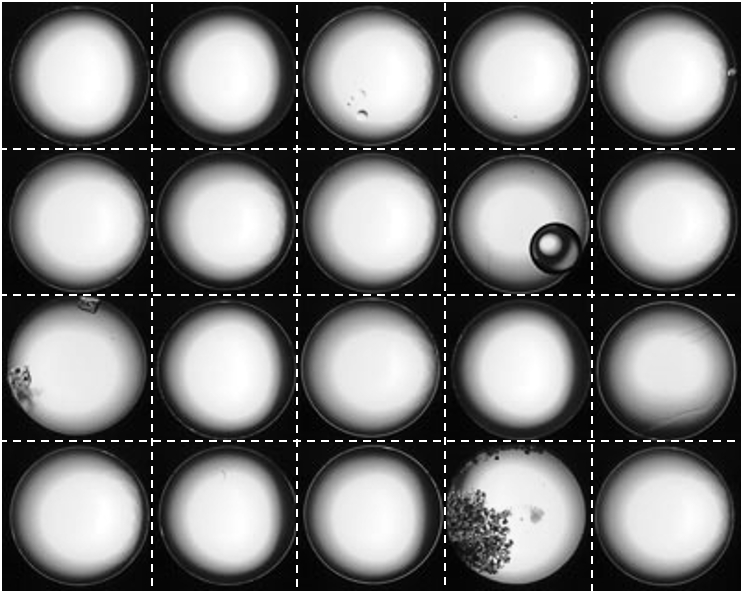
A set of images collected by the onboard camera, showing clean wells and wells containing bubbles, crystals and precipitates.
Designed with high throughput in mind
The DynaPro Plate Reader high-throughput DLS is compatible with a variety of standard clear-bottom microwell plates , allowing for seamless integration into new or existing liquid handling systems. This flexibility ensures adaptability to evolving needs and configurations.
Andrew+™ Pipetting robot
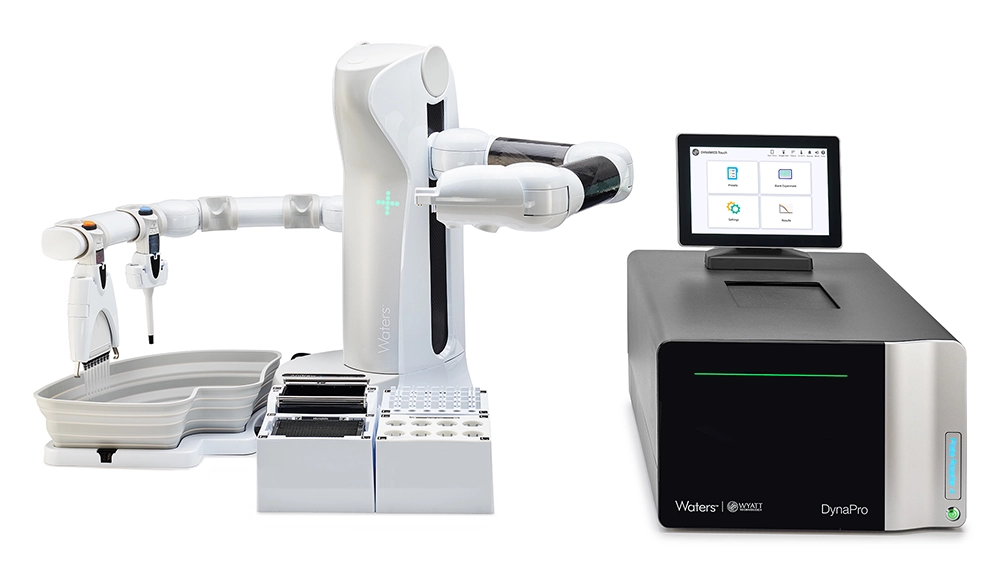
The Andrew+ pipetting robot can help with sample preparation for the DynaPro Plate Reader, reducing hands-on time for stability and formulation screening. Andrew+™ powered by OneLab™ is a modular, user-friendly pipetting robot that adapts seamlessly to various lab workflows, ensuring precision and efficiency. With OneLab™, a compliance-ready software, users can easily create and execute protocols without programming expertise, automating key workflows such as serial dilutions, concentration normalization, plate reformatting, and standard curve preparation, making lab automation more accessible, reliable, and efficient.
Lab Automation
An OLE software API is available for interfacing the DynaPro Plate Reader with robotic liquid handling systems in high-throughput laboratories. This capability enables fully automated plate loading and data collection.
Wyatt partners with several companies that provide integrated solutions for automated loading and analysis of plated samples, including Hudson Robotics, Hamilton, Caliper Life Sciences, HighRes Biosolutions, and Tecan, all of which offer custom integration services.
DYNAMICS™ - automate collecting and analyzing DLS and SLS data for full plates or single wells and control temperature ramps from a computer or through a network. It also supports Wyatt’s NanoStar™ and ZetaStar™ instruments, comparison of data collected from different days and different instruments. Determine:
- Particle size and size distributions by DLS
- Molar mass/molecular weight by SLS
- Particle concentration by SLS
- Thermal stability by protein melting temperature or aggregation onset (Tm, Tonset, Tagg) via thermal ramp
- Colloidal stability with second virial coefficient (A2 or B22) and diffusion interaction parameter (kD)
DYNAMICS Touch™ - collect and analyze DLS and SLS data and control thermal ramps directly on the touch screen with the on-board DYNAMICS Touch app. With it’s user-friendly and minimalistic interface, DYNAMICS Touch enables walk-up measurements by non-expert users, guiding them through the process and automatically assessing data quality with actionable feedback. Naturally, you can also import your DYNAMICS Touch data into DYNAMICS for more advanced analysis.
| Supported Well Plate Formats | 96, 384 or 1536 * |
| Dynamic Light Scattering | |
| Size Range (Radius, Rh) | 0.5 to 1000 nm |
| Minimum Concentration @ 14 kDa | 0.125 mg/mL † |
| Static Light Scattering | |
| Molar Mass Range | 300 Da to 1 MDa †† |
| Minimum Concentration @ 67 kDa | 1 mg/mL ††† |
| Optics | |
| Laser Wavelength | 830 nm |
| Laser Power Control | Programmable 10% – 100% |
| Attenuation Range | 1 to 105 |
| Temperature Control | 4 to 85 °C †††† |
| Fluidics | |
| Minimum Sample Volume | 4 µL ††††† |
| Data Acquisition Time | 1 to 3600 seconds per well per read |
| Read Time per Well | 5 – 20 seconds |
| Electronics | |
| Correlator | 512 channels †††††† |
| Onboard Camera | 3 megapixels ††††††† |
| Digital Communication | Ethernet (TCP/IP) |
| Dimensions | 60 cm (L) x 36 cm (W) x 25 cm (H) |
* Supports many industry standard well plates.
† Minimum concentration specified with 50 µL of Lysozyme (14 kDa) sample in a 384 well plate, Wyatt P/N P8803-384, with 100 seconds acquisition.
†† Upper limit depends on conformation: it is limited to a maximum Rh of 12 nm.
††† Minimum concentration specified with 50 µL of BSA (67 kDa) sample in a 384 well plate, Wyatt P/N P8803-384, with 100 seconds acquisition.
†††† Accuracy of ± 0.5 °C for 4 – 50 °C, and ± 1 °C for 50 – 80°C. Minimum temperature of 4 °C requires a laboratory temperature of 24 °C or below.
††††† Minimum volume specified with 2 mg/mL Lysozyme in a 1536 well plate, Wyatt P/N P8803-1536, with 25 seconds acquisition.
†††††† 100 nsec sampling time in a multi-tau layout
††††††† Camera operates with sample temperature in the range of 4-85°C.
Host PC requirements may be found in Computer Requirements.
Specifications subject to change without notice.
Other DLS & ELS instruments
DynaPro™ NanoStar™ II - With sample volumes as small as 2 µL and temperature control spanning -10 °C to +120 °C, the NanoStar goes above and beyond traditional cuvette-based DLS instruments. It offers an optimized static light scattering detector in parallel to the DLS detection system in order to determine true molar mass and reliable particle concentrations.
DynaPro™ ZetaStar™ - A manual or automated light scattering instrument for analysis of size distribution, particle concentration, molecular weight, turbidity and zeta potential of proteins, nanomedicines, gene vectors, extracellular vesicles, nanoemulsions and polymers. It uniquely measures DLS and ELS simultaneously and can measure zeta potential in salts solutions greater than physiological conditions.
